![]()
Aroids and other genera in the Collection
Take the Tour Now?
Orchids
The
Exotic Rainforest
The images on this website are copyright protected. Please contact us before any reuse.
A Private Botanical Garden
At the end of each page please click on the small photo to see more of
the garden.
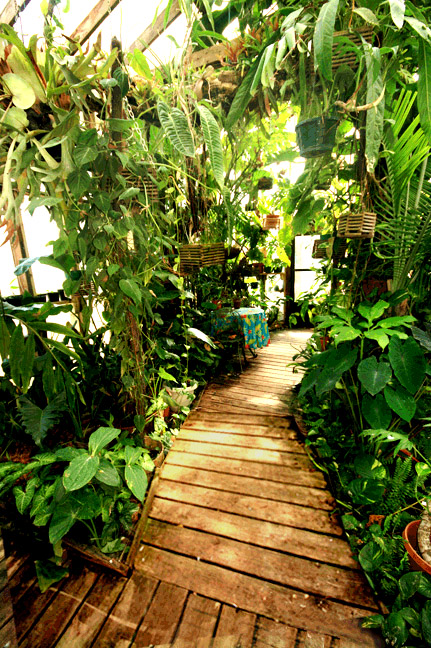
W
hen you enter the Exotic Rainforest this is the first sight you will see.The Exotic Rainforest in Northwest Arkansas is the only rain forest exhibit in the state where any visitor can walk through a living tropical forest without charge accompanied by a guide who has studied the species within the collection. A guest once said it "looks like Costa Rica under glass". These ferns are now where compatible to the old ferns you might throw out with your old furniture during your office clearance. They are strong and vibrant, colorful and tall. Like the exotic rain forest they represent, they will make you feel like you are far away, in the tropics somewhere.
Don't let the photo fool
you, the atrium is not enormous. The entire structure is not quite
8 meters by 8 meters (24 feet by 24 feet) with a 5 meter (16 foot
4 inch)
ceiling at the highest point. Constructed in 2002, it is large
enough to house a large rare plant collection that grows just like
a natural rain forest with a controlled humidity of never less than 85%,
controlled temperature never lower than 12.75 C (55 degrees F), and automatic
overhead watering. The collections includes many species of
Philodendron, Anthurium, fern and other exotic plants that have either reached or are
approaching their natural adult rain forest size!
A large number of the
plant species are
naturally
planted including exotic orchids and tropical species including flowering trees
are found in the garden along with those growing naturally on an
epiphytic tree above your head just as
you would see them in South
America! In one area is a
group of full grown banana plants that have produced delicious fruit more
than once along with a pond and almost 19,000 liters (6,000 gallons) per hour waterfall.
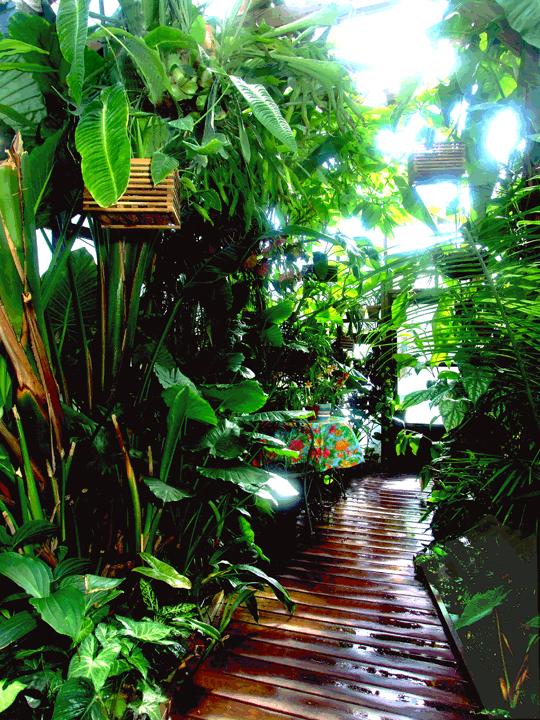 Large
Philodendron as well as Anthurium species
with almost 2 meter (6 foot)
spans hang from the ceiling creating the
sensation of walking beneath a rain forest canopy. Additionally,
the walls are lined with hanging baskets do you feel as though you are actually walking in a
South American rain forest. To add to the sensation you'll hear the sounds of
naturally falling water as well as exotic birds recorded in the rain
forest. The birds sound as though they are flying just overhead
and in the distance
you'll hear the soothing sounds of Ecuadorian pan flutes.
Large
Philodendron as well as Anthurium species
with almost 2 meter (6 foot)
spans hang from the ceiling creating the
sensation of walking beneath a rain forest canopy. Additionally,
the walls are lined with hanging baskets do you feel as though you are actually walking in a
South American rain forest. To add to the sensation you'll hear the sounds of
naturally falling water as well as exotic birds recorded in the rain
forest. The birds sound as though they are flying just overhead
and in the distance
you'll hear the soothing sounds of Ecuadorian pan flutes.
The center post has a scarce hanging
Cercestis mirabilis, the
African Embossed Plant,
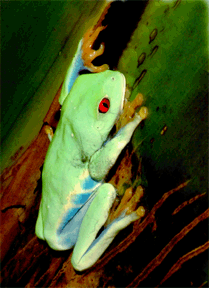 along with numerous Anthurium species, rare ferns,
Philodendron species and other
exotic species on all four sides. A large leaf
Philodendron sagittifolium
covers the entire
post and has now almost reached the ceiling. Close to 300 species
of rare plants can be found throughout the building with many very large
specimens hanging from the ceiling. The plants appear as
comfortable in the Exotic Rainforest as they would in South or Central
America since they frequently produce colorful inflorescences in the
spring and fall.
along with numerous Anthurium species, rare ferns,
Philodendron species and other
exotic species on all four sides. A large leaf
Philodendron sagittifolium
covers the entire
post and has now almost reached the ceiling. Close to 300 species
of rare plants can be found throughout the building with many very large
specimens hanging from the ceiling. The plants appear as
comfortable in the Exotic Rainforest as they would in South or Central
America since they frequently produce colorful inflorescences in the
spring and fall.
Although often difficult to locate, among their leaves you'll find 3 species of tropical tree frogs as
well as a few small green lizards known as anoles. A beautiful Blue and
Gold Macaw named Wizard also resides in the
atrium. The large pond with moderately large fish is
immediately to the right of the walk just out the kitchen door and all this is in the backyard
of colonial home built in 1890 in a small Arkansas town. We've hosted
up to 60 visitors in a single day due to
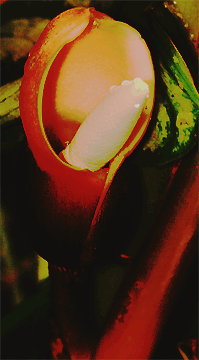 several tours offered by garden clubs
and groups of home schooled students. The Exotic Rainforest is not
a business, it is a private botanical garden and there is no charge to
visit.
several tours offered by garden clubs
and groups of home schooled students. The Exotic Rainforest is not
a business, it is a private botanical garden and there is no charge to
visit.
The Exotic Rainforest website was created to catalogue and describe the plants in the collection. Every attempt is made to be certain our plant descriptions are scientifically accurate, however, I am not a botanist. Instead, I am a retired commercial photographer who takes pleasure in showing each plant as best possible in the photographs on this site. To ensure accuracy I have developed a network of contacts who are well known botanists and seek their advice or consult scientific journals on all plant subjects. You will find many quotes from recognized scientific authorities on the pages of this site. Very little information on this site is collected from the internet since much of that information is not verified and is often inaccurate. If you believe find an error on this website please make it known. We do however verify the accuracy of any recommendation before posting corrections since the world of horticulture is filled with inaccurate information.
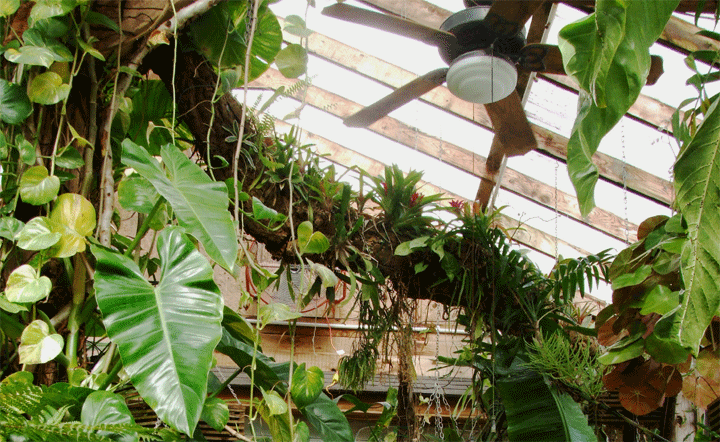 Our goal is to be accurate but do
it in a manner anyone can understand.
If
you are a return visitor you will notice this site is updated almost
daily. Many aroids and other genera in the collection have yet to be described and
photographed since we add new specimens almost every month.
In June of 2009 we brought back more than 20 scientifically collected
specimens that were made available to us from the Missouri Botanical
Garden collection in St. Louis, Missouri and in September of every year
we make a trip to Miami, Florida for the annual International Aroid
Society Show to acquire new specimens collected in South American rain
forests. Our
collection is now one of the largest in mid-America and
has been featured in one national magazine article.
Our goal is to be accurate but do
it in a manner anyone can understand.
If
you are a return visitor you will notice this site is updated almost
daily. Many aroids and other genera in the collection have yet to be described and
photographed since we add new specimens almost every month.
In June of 2009 we brought back more than 20 scientifically collected
specimens that were made available to us from the Missouri Botanical
Garden collection in St. Louis, Missouri and in September of every year
we make a trip to Miami, Florida for the annual International Aroid
Society Show to acquire new specimens collected in South American rain
forests. Our
collection is now one of the largest in mid-America and
has been featured in one national magazine article.
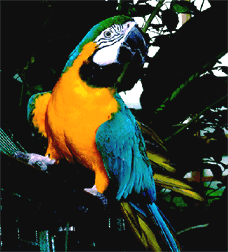 One
website visitor from London said in an email,
"if you sense
somebody sat on that seat in the atrium it's probably me"./
You'll see our bench later in this
presentation by simply following the "trail" through the forest by
clicking the last small photo on each page.
One
website visitor from London said in an email,
"if you sense
somebody sat on that seat in the atrium it's probably me"./
You'll see our bench later in this
presentation by simply following the "trail" through the forest by
clicking the last small photo on each page.
So if I can tell the bench seat is warm the next time I sit there I'll
know someone, perhaps you, has visited! You are
welcome to share our
park bench anytime via the net or in person. All we ask is a call
before you come.
The garden is open to the public
free of charge. You can find a
map on the homepage of this
website. Schools are welcome to use the garden as a rain forest
teaching tool. If you would like to continue the tour now
just follow the links at the bottom of each page by clicking on the
smaller photo. Or, if you are seeking a particular plant species
click on the link below to be taken to the list of species currently
described. Please visit!
Follow the trail by clicking on the photo to the right.
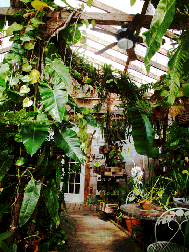
Steve & Janice Lucas
Siloam
Springs, Arkansas
See a list of the majority of the plants in the
Exotic Rainforest Collection
You can follow a "trail"
through the rain forest. Click the small photo to the right.